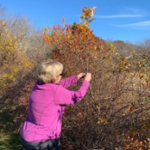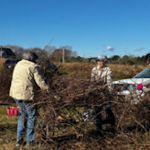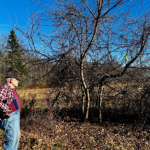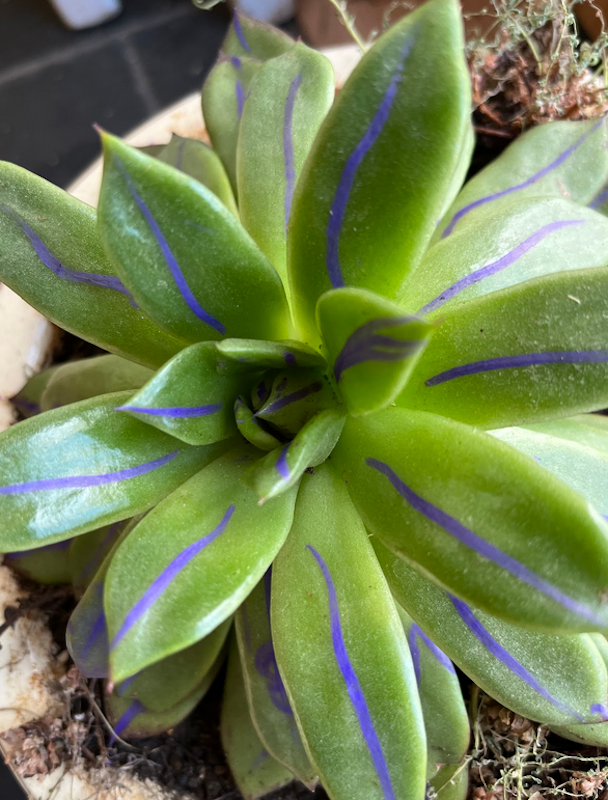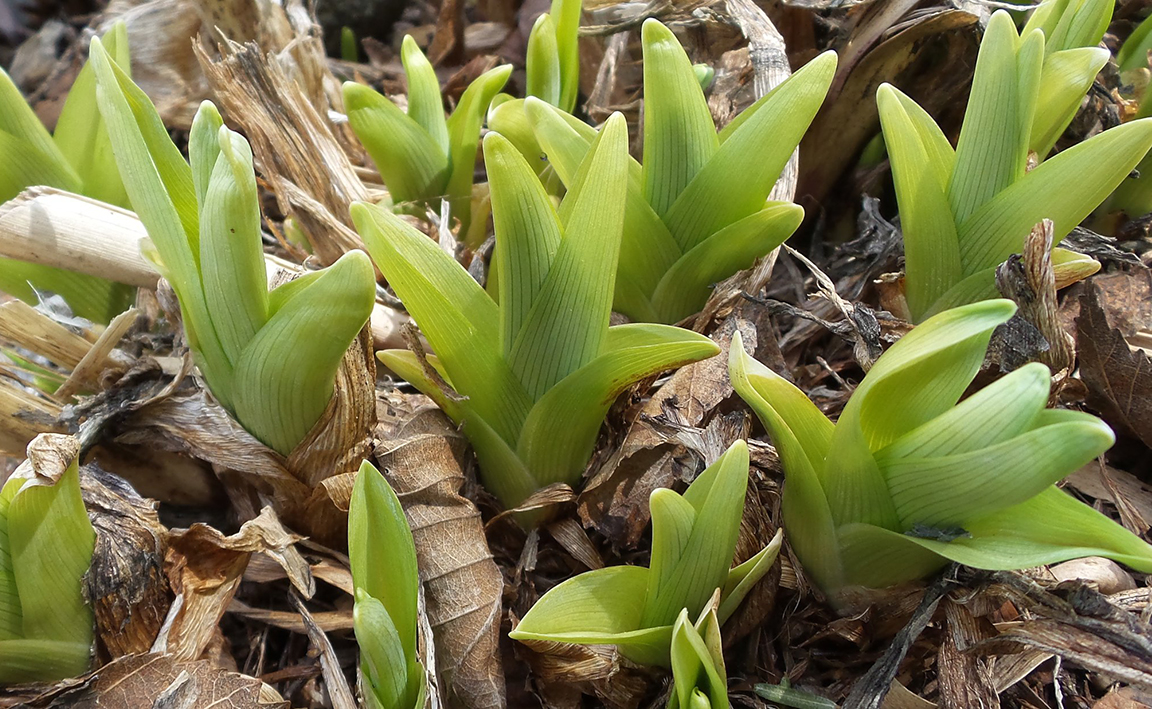
Maine Home Garden News April 2023
In This Issue:
- April Is the Month to . . .
- Invasive Plant Removal at the Wells Reserve at Laudholm
- The Tree That Broke My Heart
- The Maine Invasives Plants Field Guide can help you identify and control invasive plants in your backyards and gardens!
- Knotweed Recipes
- Backyard Bird of the Month: Pine Warbler
- Tick Management Survey
- Ask the Expert
April Is the Month to . . .
By Barbara Harrity, Penobscot County Master Gardener Volunteer
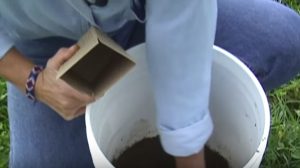 Think about soil testing. You should generally have your garden soil tested every 3–5 years, or if you notice a drop-off in productivity. It’s also good to test before adding any soil amendments. You can learn more about soil testing in Bulletin #2286, Know Your Soil: Testing Your Soil. Test kits are available from your local UMaine Extension county office or the University of Maine Analytical Laboratory and Maine Soil Testing Service. The standard soil test costs $18.
Think about soil testing. You should generally have your garden soil tested every 3–5 years, or if you notice a drop-off in productivity. It’s also good to test before adding any soil amendments. You can learn more about soil testing in Bulletin #2286, Know Your Soil: Testing Your Soil. Test kits are available from your local UMaine Extension county office or the University of Maine Analytical Laboratory and Maine Soil Testing Service. The standard soil test costs $18.- Continue starting seeds indoors. If starting your garden plants from seeds, April is a busy month. Here’s a guide for when* to start some common vegetable and flower seeds.
- Early April: pepper, eggplant, broccoli, cabbage, cauliflower, coleus, statice, impatiens, larkspur, cosmos
- Mid-April: tomato, basil, lettuce, calendula, marigold
- See Bulletin #2751, Starting Seeds at Home, for information about supplies and growing conditions
- Direct seed in the garden. If, like most gardeners, you’ve spent the last several months itching to work in your garden, by mid-April to late April* it’s generally safe to direct seed spinach, Swiss chard, and peas and to transplant onion, cabbage, and kale seedlings. Johnny’s seed-starting date calculator provides a handy planting guide based on the spring frost-free date for your location.
*In coastal Maine, plant 10–14 days earlier. In northern Maine, plant 10–14 days later.
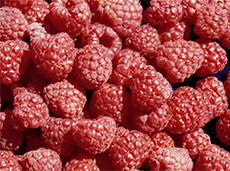 Think berries! April is a good time to remove mulch from strawberry plants, but be sure to have it nearby in case it’s needed to protect the flower buds from a spring frost. See Bulletin #2067, Growing Strawberries, for more information about growing strawberries in Maine. And late April is a good time to plant raspberries and blackberries. Bulletin #2066, Growing Raspberries and Blackberries is the perfect resource to assist you.
Think berries! April is a good time to remove mulch from strawberry plants, but be sure to have it nearby in case it’s needed to protect the flower buds from a spring frost. See Bulletin #2067, Growing Strawberries, for more information about growing strawberries in Maine. And late April is a good time to plant raspberries and blackberries. Bulletin #2066, Growing Raspberries and Blackberries is the perfect resource to assist you.- Consider growing mushrooms. If you’re in the Farmington area and interested in growing mushrooms, check out this workshop on mushroom inoculation (April 5, 2023, 5:30–7:00 p.m.) at the Cooperative Extension Office in Farmington.
- Last chance to remove browntail moth webs! Invasive browntail moth caterpillars will begin to emerge in mid-April. On top of defoliating hardwood trees and shrubs, the caterpillars also pose a health risk to people who come in contact with the poisonous hairs from the caterpillar. Visit the Maine Forest Service’s Browntail Moth webpage for more information about this invasive insect.
- Get the mower and other power tools ready for the season. Although not particularly fun, you’ll be glad to have sharp blades, fresh oil, and new spark plugs when the time comes to mow your lawn or rototill your garden.
- Put a garden-related poem in your pocket. Celebrate National Poetry Month and in particular Poem in Your Pocket Day (April 27, 2023) by exploring and sharing some poetry about gardens and gardening.
Invasive Plant Removal at the Wells Reserve at Laudholm
By Ginger Laurits and Janet Sherman, York County Master Gardener Volunteers; Photo credit to Ginger Laurits and Janet Sherman
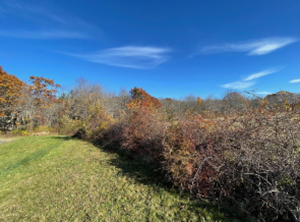
Invasive plants run rampant at the Wells Reserve at Laudholm. Oriental bittersweet, barberry, multiflora rose, buckthorn, amur honeysuckle, Eurasian grasses, and many others have overtaken much of the former agricultural landscape, out-competing our native plants. These plants have been imported from other places without their natural biological controls—the insects, plants, animals, and other factors that keep their populations in check. Warming temperatures from a changing climate favor these plants and have led to an increased rate of growth and native plant population decline.
The Native Plant Border at the Wells Reserve was planted by the York County Master Gardener Volunteers (MGVs) in 2005 as a demonstration native tree and shrub buffer border and continues to be maintained by them. Over the years, we added native wildflowers for pollinators. Bittersweet would crop up here and there, but regular cutting back kept it in check.
- Janet Sherman tags a red maple found within the invasives.
- Sue Ford, Pat Fosse, and Sally Cluskey cut back and untangle bittersweet from the wire fence.
- Dave Kiwak rests after clearing the area around several black cherry trees.
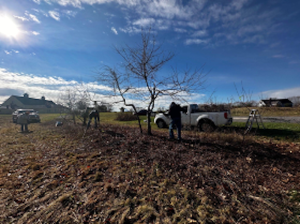
For years, we left the fence alone—the thought of attacking the invasives was daunting. Then someone started cutting. Any surviving native trees and shrubs were first identified and tagged. Out came the heavy-duty pruners, gloves, wire cutters, pickup trucks, eye protection, and a fierce determination to get the job done. We hacked, chopped, cut, untangled, and hauled truckloads of refuse to the Reserve’s burn pile.
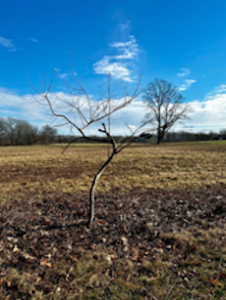
Cleared areas exposed remnant native trees and shrubs struggling to survive. Winterberry, black cherry, pussy willow, red maple, and apple trees were identified and marked. These plants were given room to stretch, breathe, and grow, and areas around them were cleared.
We are in our fourth year of invasive removal began in the fall of 2020. Goals are set for each season, and we do the bulk of the work in early spring and late into fall as the weather allows. We are pleased to report that as of fall 2022, the entire area was cleared. We know we are not done—roots remain and diligent cutting back is necessary to prevent regrowth. The Wells Reserve will bring in a backhoe for root removal, making maintenance much easier.
This project provides our Master Gardener Volunteers with an example of how they can join others to address tough invasive plant problems on their own properties or neighborhoods. Clearing has opened up a beautiful view of the fields from the entrance to the Reserve and provides an area to reestablish native trees.
One volunteer uses the rescued native species as an example of resilience in her talk, Using Nature’s Help in Healing From Grief. She notes that despite adversities in one’s past and the scars that remain, the spirit is strong and one will not only survive but also thrive.
The Tree That Broke My Heart
By Naomi Jacobs, Penobscot County Master Gardener Volunteer
A favorite tree is like an elder in the family. Because it’s always been there, you think it will live forever.
Our big Norway Maple was probably 90 years old when I moved to Bangor’s “Tree Street” neighborhood in 1983. Its massive trunk, six feet in diameter, split into multiple upper trunks, each as thick as an ordinary tree. Its canopy rose above the two-story houses on either side and easily spanned the 50-foot lot between them.
For 40 years, this tree was a stately companion. I looked forward to its delicate May blossoms, which drifted down into my coffee cup as I sat in the shade, and to the new leaves that followed, brilliant chartreuse against the blue sky. The tree shielded us from the summer heat and allowed a shade garden to flourish. Birds nested in its upper branches and squirrels used it as a highway. In October, it turned a gorgeous gold, and in November its fallen leaves carpeted the lawn.
The tree held firm through the Great Ice Storm of 1998 when our block was one of few in Bangor to keep power. With ice accumulating on that last night, we heard limbs crash all around the city and saw flashes of blue light in the sky as transformers blew. But the next morning, our tree stood glittering and unharmed. Hand in hand with a little girl whose family had sheltered with us, I went out to thank the tree for staying strong.
The tree remained as its peers on the block succumbed to age, one by one. It held on, though the power company hacked away limbs overhanging the electric lines and we pruned back limbs too close to the roof.
I knew that the Norway Maple is classified as an invasive species in Maine, and we did remove some other specimens in our yard. But this one seemed exempt. I simply had too much history with it. It had presided over my garden’s expansion from a few old lilacs, daylilies, and peonies to extensive perennial plantings, and had seen me mature from a naive young person to a wiser one.
Then one day I looked out a window and saw daylight through a crack in a large horizontal limb. The arborist removed that branch and cabled two large trunks that looked dicey. We told ourselves the tree was stable enough.
Over the next few years, the canopy thinned and leaves became smaller, indicating loss of vigor. Twiggy branches fell in windy weather. The tar spot fungal disease hit hard. When a heavy snowfall dropped a small limb and cracked a windshield, we stopped parking in that driveway on gusty nights and started to worry about a limb falling on a passerby.
It was clear that the tree had to come down. Still, we delayed. It wasn’t only because the shade garden would fry, the house would bake during hot spells, and our view of greenery would be replaced by power lines and neighboring houses. I felt a kinship with the tree and a loyalty to it. It seemed like a father or mother, frail with age. Though its time had come, I wanted it to stay just a little longer.
Several happenings finally gave me the courage to call the arborist. One was the happy way my flowering plants responded to the increased sunlight when a neighbor’s tree was removed. Suddenly a whole new area of the yard could be planted, and what gardener doesn’t like that?
Editor’s note:
This article is in no way meant to endorse keeping Norway maples in our landscapes. Instead, the intent is to strike a chord with the countless homeowners and land managers who are surprised to suddenly find some of the plants they’ve grown to deeply love and appreciate in their landscape are harmful to our ecosystems. It acknowledges the struggle that so many people face with saying goodbye to an old friend and gives a hopefully inspiring message that saying goodbye is part of life and that it’s doable and possible to move on.
For more information on identifying and managing invasive species, we encourage you to visit the Maine Natural Areas Program website and/or reach out to your local Extension office.
The Maine Invasives Plants Field Guide can help you identify and control invasive plants in your backyards and gardens!
By Catherine Spolarich, Acting Invasive Plant Biologist with the Maine Natural Areas Program, Department of Agriculture, Conservation and Forestry
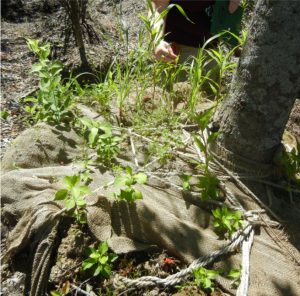
You can help protect Maine’s landscapes by managing and mapping invasive plants. Invasive plants are non-native plants that spread rapidly and cause environmental or economic harm. Most invasive plants were originally planted intentionally because of their ability to spread rapidly or because of their attractive and abundant flowers or fruits. We later learned the harm they can cause-both where they were planted and beyond into natural habitats.
Invasive species negatively impact habitat, water quality, property values, recreational values, biodiversity, and many other values important to humans, other species, and our planet. By removing invasive species, home gardeners can improve wildlife habitat and habitat for pollinators, slow the spread of invasives in the landscape, and contribute to Maine’s biodiversity and climate resiliency.
This handy, user-friendly guide describes how to identify invasive species found in Maine and nearby areas, control strategies for individual species, and provides a comprehensive section on invasive plant management, control, disposal, and monitoring. You can make a difference through careful invasive plant management while improving habitat for beneficial native plants, wildlife, pollinators, and other insects.
The Maine Invasive Plant Field Guide is available at Maine Invasive Plants – Field Guide.
For more information about invasive plants in Maine please visit Invasive Plants or email invasives.mnap@maine.gov.
Knotweed Recipes
By Chef Rob Dumas CEC, Food Science Innovation Coordinator and Facility Manager with the University of Maine School of Food and Agriculture
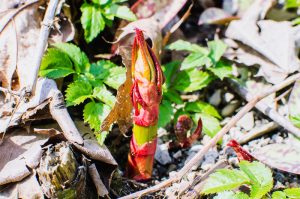
Knotweed (Fallopia japonica) is a ubiquitous and frustratingly challenging invasive plant to manage. It is not without some value though. In spring, I like to harvest the youngest, most tender shoots for use in the kitchen. In the late summer, the plant produces prodigious flowers and becomes a flurry of activity for many of the local pollinators. While it’s certainly not a “keeper” in the landscape and nothing you’d ever want to intentionally plant, it’s good to know how to “sweeten” the unsavory situation as you’re developing a management plan.
Strawberry Knotweed Jam
Makes 1 pint
Ingredients:
- Washed young tender knotweed shoots*- diced finely: 2 cups
- Fresh or frozen strawberries- hulled and sliced: 2 cups
- Sugar or maple syrup: 2 tablespoons or to taste
Method:
- Heat all ingredients in a medium saucepan over medium heat.
- Bring to a simmer and cook until slightly reduced and thickened.
- Pour into a clean jar and store in the refrigerator for up to one month.
I like to use this jam to top yogurt and granola. I also like to use it with oatmeal. For a thicker consistency, boost pectin levels naturally by adding half an apple, grated on a box grater (no need to peel), at the beginning of the cooking process. You can also add liquid or dry pectin.
Additionally, the jam can be spread thinly on a silicon mat, dried at 150f in a dehydrator, and enjoyed as fruit leather.
Strawberry Knotweed Balsamic dressing
Makes 10 portions
Ingredients:
- Knotweed jam- 2 tablespoons
- Dijon Mustard- 1 teaspoon
- Balsamic Vinegar- 1-2 tablespoons
- Olive oil or another neutral oil- 1 cup
- Salt and pepper to taste
Directions:
- Combine all ingredients except oil and whisk or blend to combine.
- While whisking/blending add oil in a steady stream.
- Season to taste with salt and pepper.
- Store in the refrigerator for up to one month.
I enjoy this dressing with a spinach, goat cheese, pecan, and dried cherry salad. It also makes a nice sauce for chicken or pork.
*Many municipalities actively battle the spread of knotweed with pesticides. Therefore, it is particularly important to source any knotweed for eating from an unsprayed patch that is adequately distanced from roadways.
Backyard Bird of the Month: Pine Warbler
By Maine Audubon Seasonal Field Naturalist Andy Kapinos
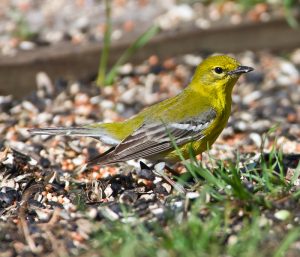
Photo by Kirk Rogers, imaged at Savannah National Wildlife Refuge, used by permission.
Pine Warblers are the first warblers to arrive in Maine every year and are a sign that spring migration is about to ramp up. The first Pine Warblers arrive back to their breeding territory around April 1, and the rest will arrive by the end of the month. These birds are never far from their namesake pines, especially during the breeding season, as they forage for insects and nest high in the canopies of pine trees. This habitat makes them hard to see, but their song of simple, clear notes trilled in rapid succession is usually the best clue to their presence, along with their habit of feeding along the branches and trunk in the canopy.
At this time of the year, Pine Warblers coexist with Dark-eyed Juncos and/or Chipping Sparrows, which have similar songs. Thankfully, neither species is regularly found in the canopy of pine trees, and neither are yellow! Pine Warblers are more frequently seen during fall migration, when they undergo physiological changes that allow them to consume a higher proportion of seeds (especially pine nuts), which is unique among warblers. They occasionally visit suet feeders and can be seen in multi-species flocks foraging on the ground. Keep this in mind as you crane your neck to get a look at these early warblers in your pines this spring
For more on the importance of Maine native plants to support birds like the Pine Warbler and other wildlife, visit Maine Audubon’s “Bringing Nature Home” webpage.
Tick Management Survey
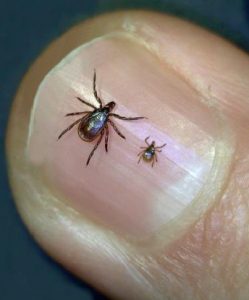
The Tick lab is a valuable resource for the state of Maine. Please consider helping them by completing this survey.
The New England Center of Excellence in Vector-Borne Diseases (NEWVEC) is seeking your help in better understanding residential tick control. NEWVEC began as a partnership of university research teams from each of the six New England states joining with state and local health departments and agricultural extension programs to discover, evaluate, and promote practices that reduce the burden of tick- and mosquito-borne diseases.
NEWVEC’s inaugural undertaking is Project ITCH, our acronym for “Is Tick Control Helping.”Project ITCH will be carried out in two phases starting spring 2023.
In Project ITCH — phase 1, NEWVEC is asking for your participation to tell us about what you are doing at your home to reduce the incidence of ticks and tick bites. Whether you are hiring a company to spray your lawn, going with a DIY approach, or just crossing your fingers, we’d like to learn more about your experience.
In Project ITCH — phase 2, NEWVEC will gather the information you share and through a lottery process select residential properties to participate in a research study to test what’s working. We will partner with you to answer the question, “Is Tick Control Helping?.” And while participating households will get free evaluation of their property, the results of Project ITCH will inform all residents about best practices to protect themselves, their families, and their pets.
It all starts with you taking a few moments to answer a few survey questions. To complete the survey, please visit our web page at NEWVEC. Participants in this survey will be eligible for consideration for Phase 2 enrollment in the future. To learn more about NEWVEC and Project ITCH, bookmark our web page NEWVEC and/or sign-up to receive updates on NEWVEC projects.
Allie Gardner, Ph.D.
Associate Professor and NEWVEC Co-Investigator
School of Biology and Ecology University of Maine, Orono
Ask the Expert!
Q. What’s wrong with my plant? The symptoms suddenly appeared around the same time my five year old child was quiet for about ten minutes.
A. Thank you for your question and photo. Your plant has clearly had an art attack.
We recommend another snow day and a few warmer colors to balance the composition.
Do you appreciate the work we are doing?
Consider making a contribution to the Maine Master Gardener Development Fund. Your dollars will support and expand Master Gardener Volunteer community outreach across Maine.
Your feedback is important to us!
We appreciate your feedback and ideas for future Maine Home Garden News topics. We look forward to sharing new information and inspiration in future issues.
Subscribe to Maine Home Garden News
Let us know if you would like to be notified when new issues are posted. To receive e-mail notifications, click on the Subscribe button below.
University of Maine Cooperative Extension’s Maine Home Garden News is designed to equip home gardeners with practical, timely information.
For more information or questions, contact Kate Garland at katherine.garland@maine.edu or 1.800.287.1485 (in Maine).
Visit our Archives to see past issues.
Maine Home Garden News was created in response to a continued increase in requests for information on gardening and includes timely and seasonal tips, as well as research-based articles on all aspects of gardening. Articles are written by UMaine Extension specialists, educators, and horticulture professionals, as well as Master Gardener Volunteers from around Maine. The following staff and volunteer team take great care editing content, designing the web and email platforms, maintaining email lists, and getting hard copies mailed to those who don’t have access to the internet: Abby Zelz*, Annika Schmidt*, Barbara Harrity*, Cindy Eves-Thomas, Kate Garland, Mary Michaud, Michelle Snowden, Naomi Jacobs*, Phoebe Call*, and Wendy Roberston.
*Master Gardener Volunteers
Information in this publication is provided purely for educational purposes. No responsibility is assumed for any problems associated with the use of products or services mentioned. No endorsement of products or companies is intended, nor is criticism of unnamed products or companies implied.
© 2023
Call 800.287.0274 (in Maine), or 207.581.3188, for information on publications and program offerings from University of Maine Cooperative Extension, or visit extension.umaine.edu.
In complying with the letter and spirit of applicable laws and pursuing its own goals of diversity, the University of Maine System does not discriminate on the grounds of race, color, religion, sex, sexual orientation, transgender status, gender, gender identity or expression, ethnicity, national origin, citizenship status, familial status, ancestry, age, disability physical or mental, genetic information, or veterans or military status in employment, education, and all other programs and activities. The University provides reasonable accommodations to qualified individuals with disabilities upon request. The following person has been designated to handle inquiries regarding non-discrimination policies: Director of Equal Opportunity, 101 Boudreau Hall, University of Maine, Orono, ME 04469-5754, 207.581.1226, TTY 711 (Maine Relay System).

